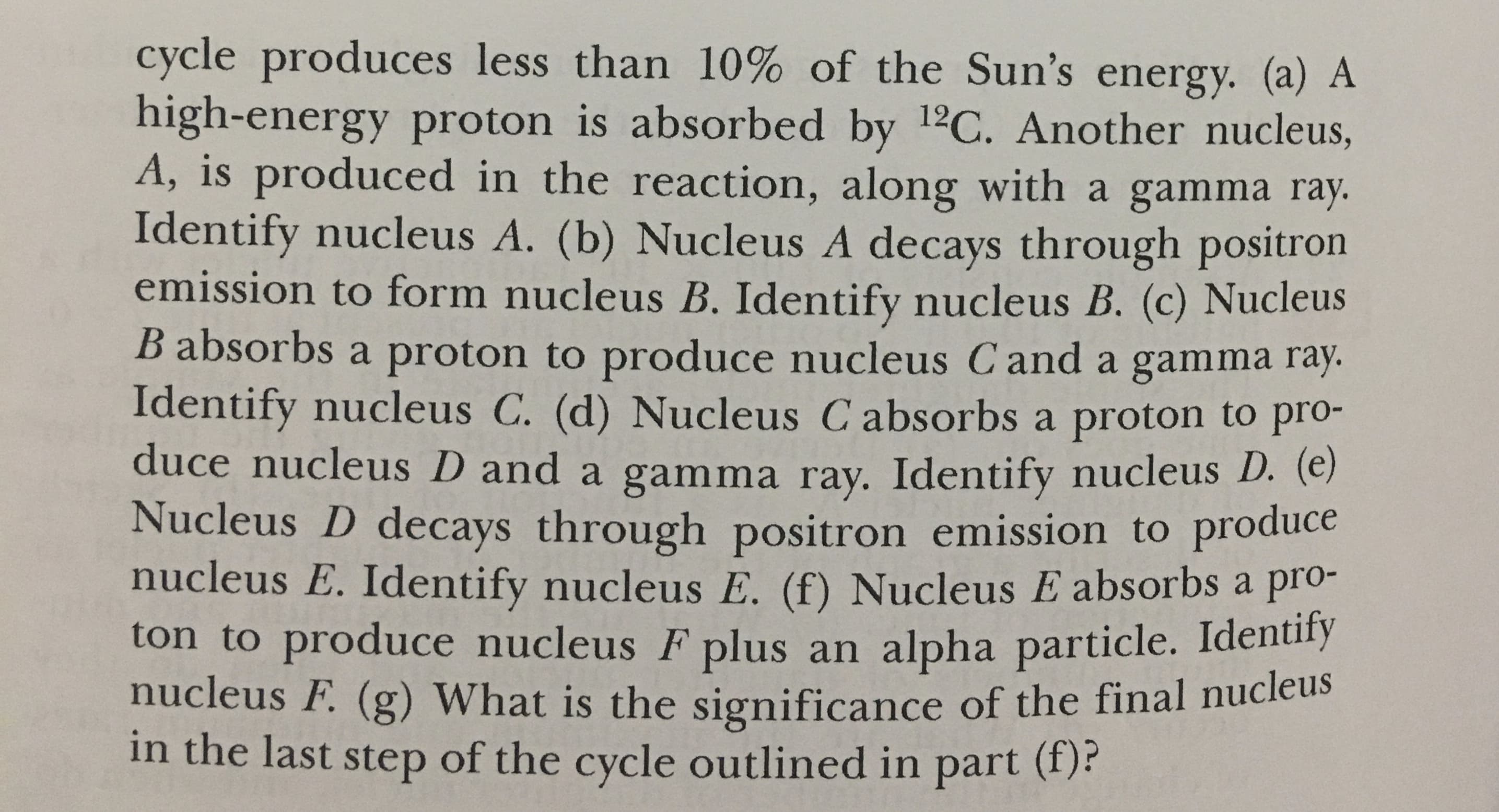38. Another series of nuclear reactions that can produce energy QC in the interior of stars is the carbon cycle first proposed by Hans Bethe in 1939, leading to his Nobel Prize in Physics in 1967. This cycle is most efficient when the central tempera- ture in a star is above 1.6 X 107 K. Because the temperature at the center of the Sun is only 1.5 X 107 K, the following cycle produces less than 10% of the Sun's energy. (a) A high-energy proton is absorbed by 12C. Another nucleus, A, is produced in the reaction, along with a gamma ray Identify nucleus A. (b) Nucleus A decays through positron emission to form nucleus B. Identify nucleus B. (c) Nucleus B absorbs a proton to produce nucleus Cand a gamma ray Identify nucleus C. (d) Nucleus C absorbs a proton to pro- duce nucleus D and a gamma ray. Identify nucleus D. (e) Nucleus D decays through positron emission to produce nucleus E. Identify nucleus E. (f) Nucleus E absorbs a pro- ton to produce nucleus F plus an alpha particle. Identiry nucleus F. (g) What is the significance of the final nucleus in the last step of the cycle outlined in part (f)
38. Another series of nuclear reactions that can produce energy QC in the interior of stars is the carbon cycle first proposed by Hans Bethe in 1939, leading to his Nobel Prize in Physics in 1967. This cycle is most efficient when the central tempera- ture in a star is above 1.6 X 107 K. Because the temperature at the center of the Sun is only 1.5 X 107 K, the following cycle produces less than 10% of the Sun's energy. (a) A high-energy proton is absorbed by 12C. Another nucleus, A, is produced in the reaction, along with a gamma ray Identify nucleus A. (b) Nucleus A decays through positron emission to form nucleus B. Identify nucleus B. (c) Nucleus B absorbs a proton to produce nucleus Cand a gamma ray Identify nucleus C. (d) Nucleus C absorbs a proton to pro- duce nucleus D and a gamma ray. Identify nucleus D. (e) Nucleus D decays through positron emission to produce nucleus E. Identify nucleus E. (f) Nucleus E absorbs a pro- ton to produce nucleus F plus an alpha particle. Identiry nucleus F. (g) What is the significance of the final nucleus in the last step of the cycle outlined in part (f)
Chapter11: Nuclear Physics
Section: Chapter Questions
Problem 11P
Related questions
Question
need help with: c,d&e

Transcribed Image Text:38. Another series of nuclear reactions that can produce energy
QC in the interior of stars is the carbon cycle first proposed by
Hans Bethe in 1939, leading to his Nobel Prize in Physics in
1967. This cycle is most efficient when the central tempera-
ture in a star is above 1.6 X 107 K. Because the temperature
at the center of the Sun is only 1.5 X 107 K, the following

Transcribed Image Text:cycle produces less than 10% of the Sun's energy. (a) A
high-energy proton is absorbed by 12C. Another nucleus,
A, is produced in the reaction, along with a gamma ray
Identify nucleus A. (b) Nucleus A decays through positron
emission to form nucleus B. Identify nucleus B. (c) Nucleus
B absorbs a proton to produce nucleus Cand a gamma ray
Identify nucleus C. (d) Nucleus C absorbs a proton to pro-
duce nucleus D and a gamma ray. Identify nucleus D. (e)
Nucleus D decays through positron emission to produce
nucleus E. Identify nucleus E. (f) Nucleus E absorbs a pro-
ton to produce nucleus F plus an alpha particle. Identiry
nucleus F. (g) What is the significance of the final nucleus
in the last step of the cycle outlined in part (f)
Expert Solution
This question has been solved!
Explore an expertly crafted, step-by-step solution for a thorough understanding of key concepts.
This is a popular solution!
Trending now
This is a popular solution!
Step by step
Solved in 8 steps with 6 images

Knowledge Booster
Learn more about
Need a deep-dive on the concept behind this application? Look no further. Learn more about this topic, physics and related others by exploring similar questions and additional content below.Recommended textbooks for you


Principles of Physics: A Calculus-Based Text
Physics
ISBN:
9781133104261
Author:
Raymond A. Serway, John W. Jewett
Publisher:
Cengage Learning

College Physics
Physics
ISBN:
9781938168000
Author:
Paul Peter Urone, Roger Hinrichs
Publisher:
OpenStax College


Principles of Physics: A Calculus-Based Text
Physics
ISBN:
9781133104261
Author:
Raymond A. Serway, John W. Jewett
Publisher:
Cengage Learning

College Physics
Physics
ISBN:
9781938168000
Author:
Paul Peter Urone, Roger Hinrichs
Publisher:
OpenStax College

Glencoe Physics: Principles and Problems, Student…
Physics
ISBN:
9780078807213
Author:
Paul W. Zitzewitz
Publisher:
Glencoe/McGraw-Hill

College Physics
Physics
ISBN:
9781305952300
Author:
Raymond A. Serway, Chris Vuille
Publisher:
Cengage Learning

College Physics
Physics
ISBN:
9781285737027
Author:
Raymond A. Serway, Chris Vuille
Publisher:
Cengage Learning